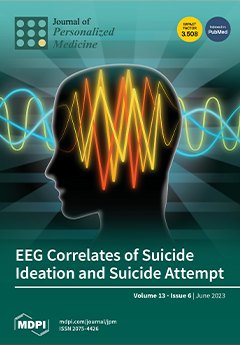Many patients with squamous cell carcinoma of the head and neck (SCCHN) receive cisplatin-based chemoradiation. Cisplatin 100 mg/m
2 every three weeks is toxic and alternative cisplatin regimens are desired. Two courses of 20 mg/m
2/day 1–5 (cumulative 200 mg/m
2)
[...] Read more.
Many patients with squamous cell carcinoma of the head and neck (SCCHN) receive cisplatin-based chemoradiation. Cisplatin 100 mg/m
2 every three weeks is toxic and alternative cisplatin regimens are desired. Two courses of 20 mg/m
2/day 1–5 (cumulative 200 mg/m
2) were shown to be similarly effective and better tolerated than 100 mg/m
2 every three weeks. Previous studies suggested that cumulative doses >200 mg/m
2 may further improve outcomes. In this study, 10 patients (group A) receiving two courses of 25 mg/m
2/day 1–5 (cumulative 250 mg/m
2) in 2022 were retrospectively matched and compared to 98 patients (group B) receiving two courses of 20 mg/m
2/day 1–5 or 25 mg/m
2/day 1–4 (cumulative 200 mg/m
2). Follow-up was limited to 12 months to avoid bias. Group A achieved non-significantly better 12-month loco-regional control (100% vs. 83%,
p = 0.27) and metastases-free survival (100% vs. 88%,
p = 0.38), and similar overall survival (89% vs. 88%,
p = 0.90). No significant differences were found regarding toxicities, completion of chemotherapy, and interruption of radiotherapy. Given the limitations of this study, chemoradiation with two courses of 25 mg/m
2/day 1–5 appears an option for carefully selected patients as a personalized treatment approach. Longer follow-up and a larger sample size are needed to properly define its role.
Full article





